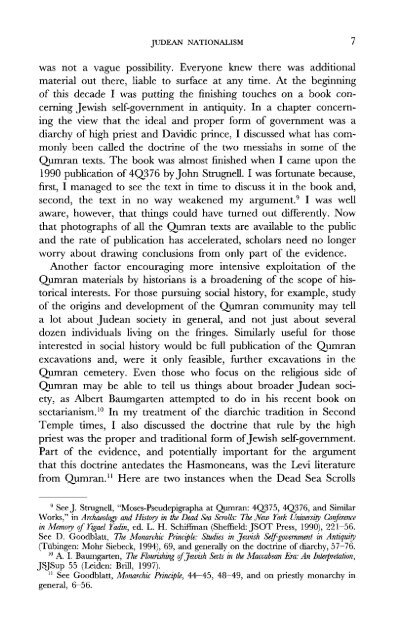historical perspectives: from the hasmoneans to bar kokhba in light ...
historical perspectives: from the hasmoneans to bar kokhba in light ...
historical perspectives: from the hasmoneans to bar kokhba in light ...
You also want an ePaper? Increase the reach of your titles
YUMPU automatically turns print PDFs into web optimized ePapers that Google loves.
JUDEAN NATIONALISM 7<br />
was not a vague possibility. Everyone knew <strong>the</strong>re was additional<br />
material out <strong>the</strong>re, liable <strong>to</strong> surface at any time. At <strong>the</strong> beg<strong>in</strong>n<strong>in</strong>g<br />
of this decade I was putt<strong>in</strong>g <strong>the</strong> f<strong>in</strong>ish<strong>in</strong>g <strong>to</strong>uches on a book concern<strong>in</strong>g<br />
Jewish self-government <strong>in</strong> antiquity. In a chapter concern<strong>in</strong>g<br />
<strong>the</strong> view that <strong>the</strong> ideal and proper form of government was a<br />
diarchy of high priest and Davidic pr<strong>in</strong>ce, I discussed what has commonly<br />
been called <strong>the</strong> doctr<strong>in</strong>e of <strong>the</strong> two messiahs <strong>in</strong> some of <strong>the</strong><br />
Qumran texts. The book was almost f<strong>in</strong>ished when I came upon <strong>the</strong><br />
1990 publication of 4Q376 by John Strugnell. I was fortunate because,<br />
first, I managed <strong>to</strong> see <strong>the</strong> text <strong>in</strong> time <strong>to</strong> discuss it <strong>in</strong> <strong>the</strong> book and,<br />
second, <strong>the</strong> text <strong>in</strong> no way weakened my argument. 9 I was well<br />
aware, however, that th<strong>in</strong>gs could have turned out differently. Now<br />
that pho<strong>to</strong>graphs of all <strong>the</strong> Qumran texts are available <strong>to</strong> <strong>the</strong> public<br />
and <strong>the</strong> rate of publication has accelerated, scholars need no longer<br />
worry about draw<strong>in</strong>g conclusions <strong>from</strong> only part of <strong>the</strong> evidence.<br />
Ano<strong>the</strong>r fac<strong>to</strong>r encourag<strong>in</strong>g more <strong>in</strong>tensive exploitation of <strong>the</strong><br />
Qumran materials by his<strong>to</strong>rians is a broaden<strong>in</strong>g of <strong>the</strong> scope of <strong>his<strong>to</strong>rical</strong><br />
<strong>in</strong>terests. For those pursu<strong>in</strong>g social his<strong>to</strong>ry, for example, study<br />
of <strong>the</strong> orig<strong>in</strong>s and development of <strong>the</strong> Qumran community may tell<br />
a lot about Judean society <strong>in</strong> general, and not just about several<br />
dozen <strong>in</strong>dividuals liv<strong>in</strong>g on <strong>the</strong> fr<strong>in</strong>ges. Similarly useful for those<br />
<strong>in</strong>terested <strong>in</strong> social his<strong>to</strong>ry would be full publication of <strong>the</strong> Qumran<br />
excavations and, were it only feasible, fur<strong>the</strong>r excavations <strong>in</strong> <strong>the</strong><br />
Qumran cemetery. Even those who focus on <strong>the</strong> religious side of<br />
Qumran may be able <strong>to</strong> tell us th<strong>in</strong>gs about broader Judean society,<br />
as Albert Baumgarten attempted <strong>to</strong> do <strong>in</strong> his recent book on<br />
sectarianism. 10 In my treatment of <strong>the</strong> diarchic tradition <strong>in</strong> Second<br />
Temple times, I also discussed <strong>the</strong> doctr<strong>in</strong>e that rule by <strong>the</strong> high<br />
priest was <strong>the</strong> proper and traditional form of Jewish self-government.<br />
Part of <strong>the</strong> evidence, and potentially important for <strong>the</strong> argument<br />
that this doctr<strong>in</strong>e antedates <strong>the</strong> Hasmoneans, was <strong>the</strong> Levi literature<br />
<strong>from</strong> Qumran. 11 Here are two <strong>in</strong>stances when <strong>the</strong> Dead Sea Scrolls<br />
9 See J. Strugnell, "Moses-Pseudepigrapha at Qumran: 4Q375, 4Q376, and Similar<br />
Works," <strong>in</strong> Archaeology and His<strong>to</strong>ry <strong>in</strong> <strong>the</strong> Dead Sea Scrolls: The New York University Conference<br />
<strong>in</strong> Memory of Yigael Yad<strong>in</strong>, ed. L. H. Schiffman (Sheffield: JSOT Press, 1990), 221-56.<br />
See D. Goodblatt, The Monarchic Pr<strong>in</strong>ciple: Studies <strong>in</strong> Jewish Self-government <strong>in</strong> Antiquity<br />
(Tub<strong>in</strong>gen: Mohr Siebeck, 1994), 69, and generally on <strong>the</strong> doctr<strong>in</strong>e of diarchy, 57-76.<br />
10 A. I. Baumgarten, The Flourish<strong>in</strong>g of Jewish Sects <strong>in</strong> <strong>the</strong> Maccabean Era: An Interpretation,<br />
JSJSup 55 (Leiden: Brill, 1997).<br />
11 See Goodblatt, Monarchic Pr<strong>in</strong>ciple, 44-45, 48-49, and on priestly monarchy <strong>in</strong><br />
general, 6~56.

















